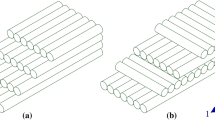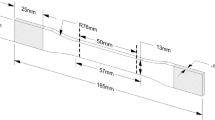Abstract
Fused deposition modelling (FDM) has emerged as an economical additive manufacturing method having the potential to fabricate functional components. Dynamic behaviour of FDM components is of great interest while designing and printing them for functional applications. This paper presents a methodology to describe the dynamic characteristics of FDM, combining the features of thermoplastic material and build parameters adopted in fabrication. The viscoelastic characteristics of thermoplastic filament induce time–temperature dependence in FDM components. The viscoelastic characteristic of the polymer is determined by dynamical mechanical analysis. Layer height is a significant build parameter that determines void geometry even in 100% infill printing, that influences mechanical properties of these additive manufactured components. Dynamic response of FDM 3D-printed parts is highly dependent on viscoelastic characteristics of polymer filaments and build parameters associated with printing. In the study, micro-scale models representing the features of actual cross section morphology with different layer heights are identified as representative volume element (RVE) models. Harmonic analysis is conducted on the RVE models using polymer material data approximated with generalized Maxwell model to determine the dynamic characteristics of the FDM print. The numerical analysis reveals orthotropic viscoelastic nature with maximum stiffness along the direction of filament deposition (raster) direction followed by transverse and vertical directions. A drastic reduction in the FDM component stiffness was observed at lower straining rates. The characteristics determined on RVE can be homogenized to the entire structure based on its print conditions and can be used for designing functional components.





Similar content being viewed by others
References
Mohan N, Senthil P, Vinodh S, Jayanth N (2017) A review on composite materials and process parameters optimisation for the fused deposition modelling process. Virtual Phys Prototyp 2759:47–59. https://doi.org/10.1080/17452759.2016.1274490
Yang C, Wang B, Li D, Tian X (2017) Modelling and characterisation for the responsive performance of CF/PLA and CF/PEEK smart materials fabricated by 4D printing. Virtual Phys Prototyp 12:69–76. https://doi.org/10.1080/17452759.2016.1265992
Miyase A, Qu S, Lo KH, Wang SS (2020) Elevated-temperature thermal expansion of PTFE/PEEK matrix composite with random-oriented short carbon fibers and graphite flakes. J Eng Mater Technol 142:1–10. https://doi.org/10.1115/1.4045158
Isakov DV, Lei Q, Castles F, Stevens CJ, Grovenor CRM, Grant PS (2016) 3D printed anisotropic dielectric composite with meta-material features. Mater Des 93:423–430. https://doi.org/10.1016/j.matdes.2015.12.176
Sathies T, Senthil P, Prakash C (2019) Application of 3D printed PLA-carbon black conductive polymer composite in solvent sensing. Mater Res Express 6:115349. https://doi.org/10.1088/2053-1591/ab5040
Jayanth N, Senthil P (2019) Application of 3D printed ABS based conductive carbon black composite sensor in void fraction measurement. Compos Part B 159:224–230. https://doi.org/10.1016/j.compositesb.2018.09.097
Schmitz DP, Ecco LG, Dul S, Pereira ECL, Soares BG, Barra GMO, Pegoretti A (2018) Electromagnetic interference shielding effectiveness of ABS carbon-based composites manufactured via fused deposition modelling. Mater Today Commun 15:70–80. https://doi.org/10.1016/j.mtcomm.2018.02.034
Sathies T, Senthil P, Anoop MS (2020) A review on advancements in applications of fused deposition modelling process. Rapid Prototyp J. https://doi.org/10.1108/RPJ-08-2018-0199
Somireddy M, Singh CV, Czekanski A (2020) Mechanical behaviour of 3D printed composite parts with short carbon fiber reinforcements. Eng Fail Anal 107:1–13. https://doi.org/10.1016/j.engfailanal.2019.104232
Huang B, Singamneni S (2015) Raster angle mechanics in fused deposition modelling. J Compos Mater 49:363–383. https://doi.org/10.1177/0021998313519153
Croccolo D, De Agostinis M, Olmi G (2013) Experimental characterization and analytical modelling of the mechanical behaviour of fused deposition processed parts made of ABS-M30. Comput Mater Sci 79:506–518. https://doi.org/10.1016/j.commatsci.2013.06.041
Dizon JRC, Espera AH Jr, Chen Q, Advincula RC (2018) Review mechanical characterization of 3D-printed polymers. Addit. Manuf. 2018:44–67. https://doi.org/10.1016/j.addma.2017.12.002
Mcilroy C, Olmsted PD (2017) Disentanglement effects on welding behaviour of polymer melts during the fused- fi lament-fabrication method for additive manufacturing. Polymer (Guildf). 123:376–391. https://doi.org/10.1016/j.polymer.2017.06.051
Abbott AC, Tandon GP, Bradford RL, Koerner H, Baur JW (2018) Process-structure-property effects on ABS bond strength in fused filament fabrication. Addit Manuf 19:29–38. https://doi.org/10.1016/j.addma.2017.11.002
Somireddy M, Czekanski A (2020) Anisotropic material behavior of 3D printed composite structures: material extrusion additive manufacturing. Mater Des. https://doi.org/10.1016/j.matdes.2020.108953
Kumar Mishra SP (2020) Prediction of in-plane stiffness of multi-material 3D printed laminate parts fabricated by FDM process using CLT and its mechanical behaviour under tensile load. Mater Today Commun 45:50. https://doi.org/10.1016/j.mtcomm.2020.100955
Casavola C, Cazzato A, Moramarco V, Pappalettere C (2016) Orthotropic mechanical properties of fused deposition modelling parts described by classical laminate theory. Mater Des 90:453–458. https://doi.org/10.1016/j.matdes.2015.11.009
Roy Xu L, Leguillon D (2020) Dual-notch void model to explain the anisotropic strengths of 3D printed polymers. J Eng Mater Technol 142:3–6. https://doi.org/10.1115/1.4044282
Calneryte D, Barauskas R, Milasiene D, Maskeliunas R, Neciunas A, Ostreika A, Patasius M, Krisciunas A (2018) Multi-scale finite element modeling of 3D printed structures subjected to mechanical loads. Rapid Prototyp J 24:177–187. https://doi.org/10.1108/RPJ-05-2016-0074
Somireddy M, Czekanski A (2017) Mechanical characterization of additively manufactured parts by FE modeling of mesostructure 1–21. https://doi.org/10.3390/jmmp1020018
Rodríguez JF, Thomas JP, Renaud JE (2003) Mechanical behavior of acrylonitrile butadiene styrene fused deposition materials modeling. Rapid Prototyp J 9:219–230. https://doi.org/10.1108/13552540310489604
Anoop MS, Senthil P (2019) Homogenisation of elastic properties in FDM components using microscale RVE numerical analysis. J Braz Soc Mech Sci Eng. https://doi.org/10.1007/s40430-019-2037-8
Michels J, Widmann R, Czaderski C, Allahvirdizadeh R, Motavalli M (2015) Glass transition evaluation of commercially available epoxy resins used for civil engineering applications. Compos Part B Eng 77:484–493. https://doi.org/10.1016/j.compositesb.2015.03.053
Selva Priya M, Naresh K, Jayaganthan R, Velmurugan R (2019) A comparative study between in-house 3D printed and injection molded ABS and PLA polymers for low-frequency applications. Mater Res Express 6:085345. https://doi.org/10.1088/2053-1591/ab2776
Liebig WV, Jackstadt A, Sessner V, Weidenmann KA, Kärger L (2019) Frequency domain modelling of transversely isotropic viscoelastic fibre-reinforced plastics. Compos Sci Technol 180:101–110. https://doi.org/10.1016/j.compscitech.2019.04.019
Pathan MV, Tagarielli VL, Patsias S (2017) Numerical predictions of the anisotropic viscoelastic response of uni-directional fibre composites. Compos Part A Appl Sci Manuf 93:18–32. https://doi.org/10.1016/j.compositesa.2016.10.029
Pelayo F, Lamela-Rey MJ, Muniz-Calvente M, López-Aenlle M, Álvarez-Vázquez A, Fernández-Canteli A (2017) Study of the time-temperature-dependent behaviour of PVB: application to laminated glass elements. Thin Walled Struct 119:324–331. https://doi.org/10.1016/j.tws.2017.06.030
Kopal I, Harničárová M, Valíček J, Kušnerová M (2017) Modeling the temperature dependence of dynamic mechanical properties and visco-elastic behavior of thermoplastic polyurethane using artificial neural network. Polymers (Basel). https://doi.org/10.3390/polym9100519
Reichl KK, Inman DJ (2018) Dynamic mechanical and thermal analyses of objet connex 3D printed materials. Exp Technol 42:19–25. https://doi.org/10.1007/s40799-017-0223-0
Stratasys (2013) 3D Printing a space vehicle
Joshi SC, Sheikh AA (2015) 3D printing in aerospace and its long-term sustainability. Virtual Phys Prototyp 10:175–185. https://doi.org/10.1080/17452759.2015.1111519
Kaliske M, Rothert H (1997) Formulation and implementation of three-dimensional viscoelasticity at small and finite strains. Comput Mech 19:228–239. https://doi.org/10.1007/s004660050171
Findley WN, Lai JS, Onaran K (1976) Creep and relaxation of nonlinear viscoelastic materials with an introduction to linear. Viscoelasticity. https://doi.org/10.1016/0032-3861(78)90187-8
Serban D-A (2016) Viscoplastic behaviour of polyamides. Viscoelastic Viscoplastic Mater. https://doi.org/10.5772/64563
ANSYS Workbench 19.0 User’s Guide (2019) ANSYS Workbench 19.0 User’s Guide, 4.7.3.1 Prony Series Complex Modulus
Henriques IR, Borges LA, Costa MF, Soares BG, Castello DA (2018) Comparisons of complex modulus provided by different DMA. Polym Test 72:394–406. https://doi.org/10.1016/j.polymertesting.2018.10.034
ASTM International (2012) ASTM D4065-Standard Practice for Plastics: Dynamic Mechanical Properties—Determination and Report of Procedures. https://doi.org/10.1520/d4065-12.1.8
Williams ML, Landel RF, Ferry JD (1955) The temperature dependence of relaxation mechanisms in amorphous polymers and other glass-forming liquids. J Am Chem Soc 77:3701–3707. https://doi.org/10.1021/ja01619a008
Bartolini L, Iannuzzi D, Mattei G (2018) Comparison of frequency and strain-rate domain mechanical characterization. Sci Rep 8:1–11. https://doi.org/10.1038/s41598-018-31737-3
Yan S, Deng J, Bae C, Kalnaus S, Xiao X (2020) Orthotropic viscoelastic modeling of polymeric battery separator. J Electrochem Soc 167:090530. https://doi.org/10.1149/1945-7111/ab8a99
Author information
Authors and Affiliations
Corresponding author
Ethics declarations
Conflict of interest
The article titled ‘An investigation on viscoelastic characteristics of 3D-printed FDM components using RVE numerical analysis’ is our original research work and has not been submitted to, nor is under review at, another journal or other publishing venue. All authors included in the manuscript have contributed towards the conceptual design, analysis interpreting results and preparing the manuscript. Further, the authors declare that they have no known competing financial interests or personal relationships that could have appeared to influence the work reported in this paper.
Additional information
Technical Editor: Aurelio Araujo.
Publisher's Note
Springer Nature remains neutral with regard to jurisdictional claims in published maps and institutional affiliations.
Rights and permissions
About this article
Cite this article
Anoop, M.S., Senthil, P. & Sooraj, V.S. An investigation on viscoelastic characteristics of 3D-printed FDM components using RVE numerical analysis. J Braz. Soc. Mech. Sci. Eng. 43, 38 (2021). https://doi.org/10.1007/s40430-020-02724-5
Received:
Accepted:
Published:
DOI: https://doi.org/10.1007/s40430-020-02724-5




